
This lesson explores foundational concepts in human anatomy and physiology, guiding students through the structural organisation of the body and the essential functions that sustain life. Questions span three tiers—basic recall, applied understanding, and clinical reasoning—each reinforcing knowledge of anatomical terminology, directional terms, body planes, organ systems, cavities, and physiological processes.
At the basic level, learners identify key body regions (e.g., femoral, brachial), cavities (cranial, thoracic), and system functions (circulatory, lymphatic). Terms like “distal,” “proximal,” and “superficial” are introduced with contextual examples, while feedback mechanisms, such as negative feedback in temperature regulation or glucose control, are emphasised. Application-based questions challenge students to analyze organ positioning using quadrants and regions, interpret roles of membranes like pleura and peritoneum, and explain tools used in clinical assessments (e.g., auscultation and percussion). Clinical scenarios, such as a stroke or abdominal trauma, ask students to apply anatomical knowledge to real-world medical cases—linking symptoms to likely structures or systems affected.
The format promotes critical thinking, builds diagnostic reasoning, and prepares learners to confidently navigate anatomical terminology and physiological concepts in both academic and clinical settings.